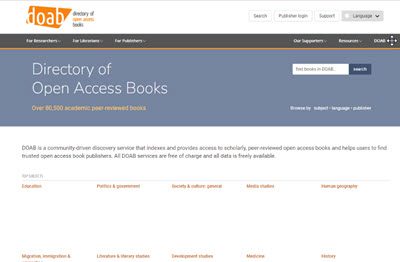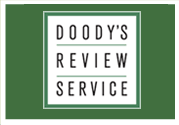|
Open Access (OA) content – that is, scholarly content that is freely available to read without registration or payment – is most often thought of in relation to journals and articles, but a healthy market for monographs exists, as well. For various reasons, publishing and tracking OA monographs is both simpler and more complex than working with OA journals. OA monographs may be available online for free yet also have a print version. Collection development librarians can choose to buy print copies of particularly relevant titles, or they can simply add bibliographic records for these titles to their library catalogs or discovery layers, and then direct patrons to online versions of the resources. But finding and tracking those OA titles is a significant challenge, and even the definition of an online monograph can be a bit tricky. The Directory of Open Access Books (DOAB), at DOABooks.org, is here to help, somewhat. With many caveats, it is a tool that many collection development librarians, and some individual researchers, can use to their advantage.
Content
DOAB is, at its heart, a free directory of books that are freely available to read and share online. DOAB does not host OA books, though its counterpart and parent organization, OAPEN (OAPEN.org), does provide hosting services to publishers. Instead, DOAB provides a search platform for discovering relevant OA books, along with many forms of title metadata for those books, which librarians can download and incorporate into their own catalogs. DOAB ensures a level of quality by requiring that only legitimate publishers (including OAPEN) may submit information about their OA books to the DOAB database. An individually published title, regardless of its quality, will not get listed in DOAB.

Figure 1: DOAB homepage and top subject areas. Credit: DOAB
DOAB incorporates content from numerous languages and subjects. The full DOAB collection identifies over 80,000 fully OA monographs, assigned to some 2,700 different subject headings. While the full directory contains about 47,000 titles in English, it also contains just over 11,000 titles each in French and German, 4,000 in Spanish, 3,400 in Italian, and many others as well, including one in Klingon from the Star Trek universe.
Features/Functionality
Searching by those 2700 subjects is a bit tricky. It is difficult to know which subject headings exist or where they come from; at times they are very broad, while in other instances they can be quite specific. Typing in “cardio” will provide the only two topic headings that start with those letters: “Cardiothoracic surgery” and “Cardiovascular medicine”. It takes some poking around to determine that “cardiology” is not a valid subject heading, or what the proper subject heading is in this case.
A library can use DOAB as an efficient way of incorporating metadata about a broad swath of freely accessible ebooks into its catalog. In addition to the various metadata feeds (ONIX, KBART, MARCXML, CSV, etc.) available directly from DOAB, Penn State University has recently begun creating full MARC records for DOAB content. Downloading and adding all this information to the catalog or discovery layer can be pretty straightforward and may well be worth doing for large, general topic libraries. For subject-specific libraries, however, things get a bit more complex, and the value of using DOAB to identify and import only some of the collection becomes much less obvious.

Figure 2: A screenshot of Selective Exports on DOAB. Credit: DOAB
A page on downloading metadata provides information about how to select title metadata by subject heading, date added, date published, publisher, and the like, but the process does not appear easy. With time, users should be able to use the “Selective Export” functionality to identify metadata that represents all titles in a specific subject area, from a specific publisher, or since a specific date. A dedicated data wrangler could set up a script to automatically collect relevant information about new titles in selected fields every several months. The MARC record set is a different challenge: it is a single file of all records available at a certain moment in time, so to add titles in selected subject areas catalogers would need to download the full set, search for relevant individual records, extract them, and then import those into the catalog. It is not a quick task especially if there are hundreds of titles on a specific subject. Given the challenges of seeking titles only in certain subject areas, it is hard to see how the current structure of DOAB would allow for the easy and regular addition of topic-specific titles to a library catalog.
Business Model
At its core, DOAB is a reflection of what is available among OA monographs, and should be considered with that in mind. A search for books in endocrinology at the time of this review, for example, returns 222 titles, and nearly every single one is either a collection of chapters gathered into a book by OA publisher IntechOpen, or is a collection of at least 10 essays published by OA publisher Frontiers, in their Special Topics series. In both cases, some care should be taken – these major OA publishers earn revenue through Article Processing Charges (APCs), which are paid when an article (or chapter) is accepted, so their primary interest is arguably in increasing publishing, rather than creating a resource that supports increased subscriptions. It is a structural problem of today’s OA environment, and along with the well-documented paper mills that sell authorship or citations to benefit individual researchers, one must recognize that there is a higher likelihood of suspect or problematic scholarly content among OA publishing than among subscription or purchase-based publishing.
Breakthrough
DOAB provides a valuable, if bumpy, method for identifying and sharing freely-accessible monographic content. For specialized libraries, using DOAB to efficiently incorporate metadata into the library catalog or discovery layer may or may not be worth the time it would take to complete the task. The content that DOAB identifies varies greatly in quality, though that is a reflection of the Open Access marketplace in 2024, not of DOAB itself. Whether or not DOAB provides utility for medical collection development librarians varies greatly from librarian to librarian and from institution to institution, but it is worth exploring and understanding this website’s strengths and limitations.
|
